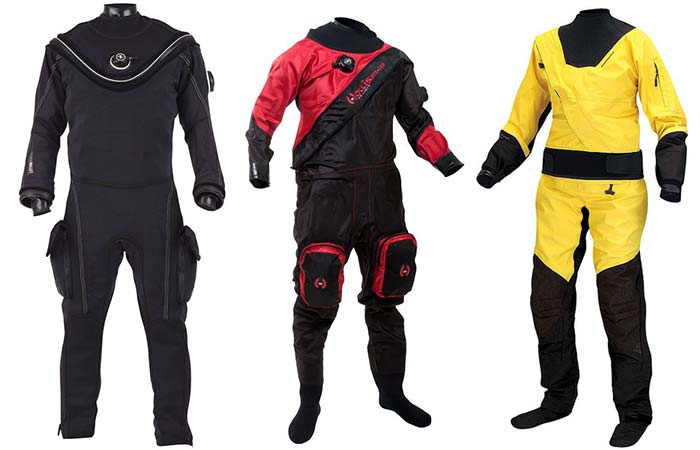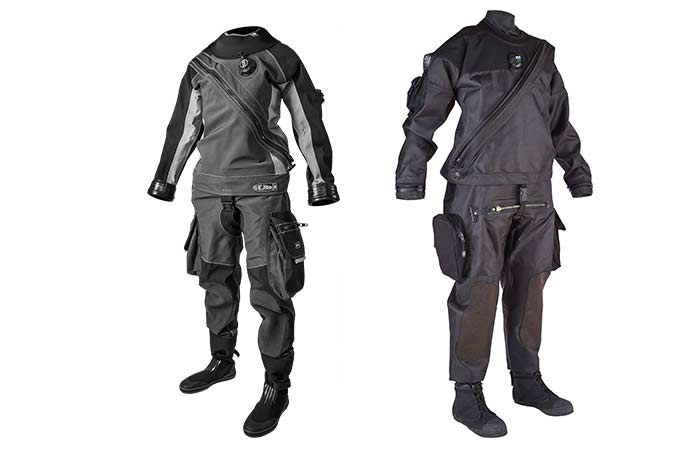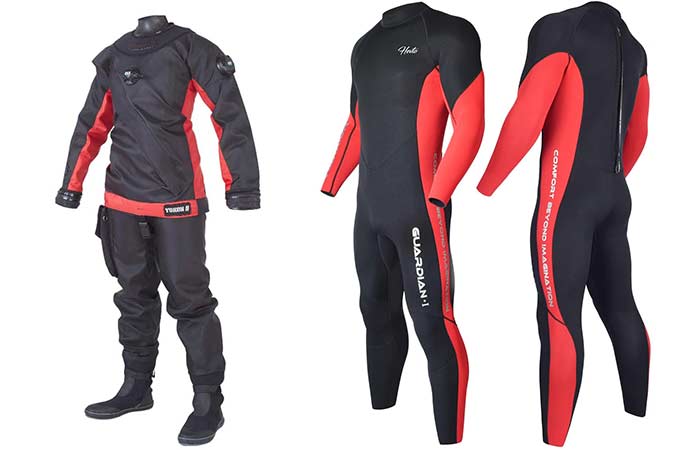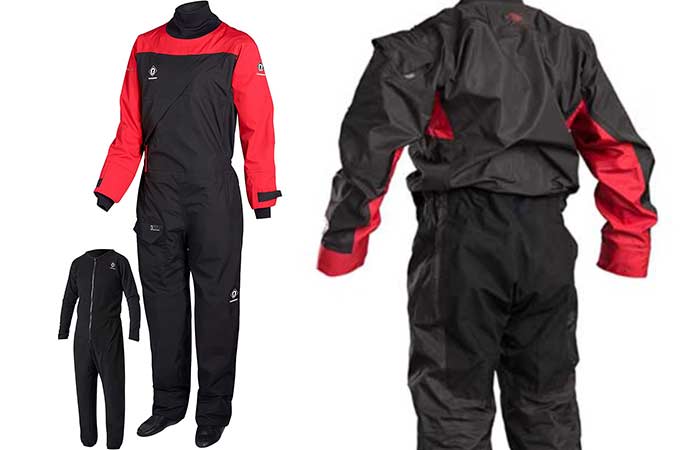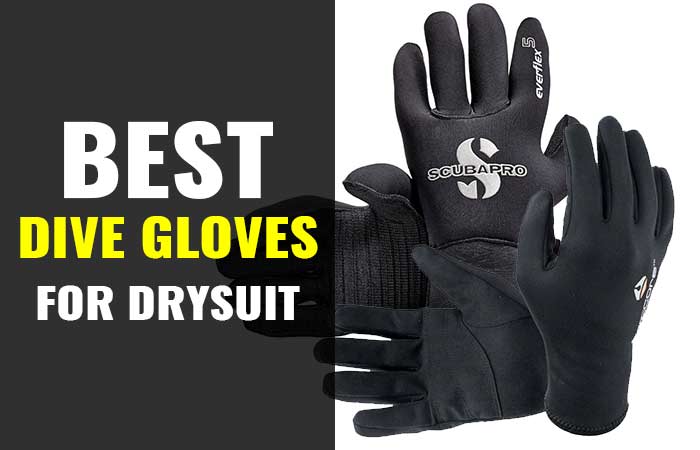Drysuit Undergarments – What to Wear Under Drysuit
A drysuit is primarily designed to keep you dry and warm. It offers a full body coverage keeping the water from coming into contact with your skin thus making your stay, deep in the waters, comfortable.
Even with this coverage, you still may need cloths under it to keep you warm and stay hygienic while at it. The type of undergarment you go for will depend on the water temperature, the drysuit type and manufacturer and how the undergarment responds to heat, wetness and other relevant aspects.
Besides the undergarments on the body, you also need to cover the head, feet, and hands since these usually aren’t covered by the drysuit. The following is a detailed discussion on what to wear underneath your drysuit
Body Undergarments
Of the two main types of drysuits (Neoprene & Trilaminate), neoprene is very thick and waterproof hence may not require undergarments.
Trilaminate designs are usually thin and lightweight. The materials from which they are made hardly provide warmth on their own hence additional undergarments are required to improve warmth and comfort. In fact, some manufacturers package their trilaminate drysuits with undergarments.
If your drysuit came without undergarments, the most common underneath garments include multiple fleece and synthetic layers. The temperature of the water temperature will determine the amount of clothes needed.
Simply begin with a thin, short sleeve synthetic top and add enough layers of fleece to keep you warm. Fleece is rated as 50, 100, 200, 300, etc. and the higher the rating, the warmer and thicker the fleece. Avoid too much fleece as this may lead to overheating.
A thin (maybe 100-200 weight) thinsulate jumpsuit, a fleece jumpsuit, and 7mm hood and gloves can keep warm as well.

Head, Hands & Feet
While the drysuit will cover to your neck, wrists and ankles, you’ll need to cover your head, hands and feet as follows:
The Head
First, you need a hood with a perfect fit then an undergarment for it. The undergarment can be made from neoprene or fleece to make the head warmer. The head is the most important part of the body when it comes to insulating your body from the cold.
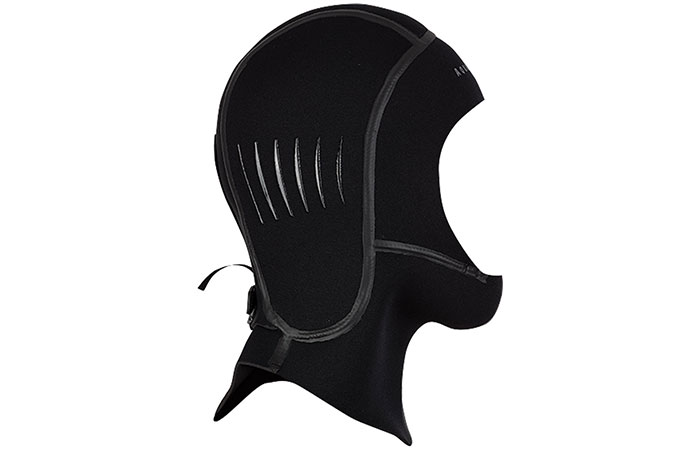
The Hands
To keep your hands warm and functional, you need warm gloves or mittens over your hands. You can use neoprene mittens, poggies, neoprene gloves or a combination of them.
The Feet
For your feet, you will need good quality neoprene socks and the appropriate boots for your dive. If you let your feet get cold, your whole body will get cold no matter how much you would have insulated yourself.
With the right drysuit and the head, hands and feet also cushioned well from the cold, you won’t suffer from the cold however cold the water will be. Avoid cold shock which can easily kill you if you jump into cold water without the right gear.
Drysuit Undersuits
Drysuit undersuits are clothes that are specifically created to be worn underneath drysuits. Just like the other undergarments, they offer thermal protection when you go under. They achieve this by trapping air and maintaining body heat.
Undersuits range from one-piece, two-piece, traditional duvet-like onesies, and skin-tight garments made of synthetic materials.
Contemporary undersuit designs can range from simple fleece type garments to advanced suits with anti-compression panels or even built-in heating. Following is video on undersuits.
Factors to Consider When Choosing Drysuit Undergarments
When choosing a drysuit and what to wear under it, consider the following aspects:
The water temperature
The temperature of the water you’re to dive in, coupled with winds and the rain will determine how many layers and thickness of undergarments you’ll be needing when you dive into the water. Don’t be mistaken into thinking if the air is warm the water will automatically be warm since it rarely works that way.
The time you expect to spend in the water
Depending on the time you expect to spend in the water, you need to choose material that keeps you warm for that period of time. At times, you may be under the water for a whole day hence the need to get the right material for such a task.
The underwater activity in question
The activity determines how much heat you will be generating from your body. If, for example, you will be doing lots of movement in and on the water, you will need slightly lighter undergarment to avoid overheating. On the other hand, if you will be mostly paddling around in slow motions, you will need heavier undergarments.
Your body’s response to temperature
Different people respond differently to temperature with some being more sensitive than others. Depending on how responsive you are to temperature, you should find the right type and amount of undergarment.
With these aspects in mind, you should find yourself the right type and thickness of drysuit undergarments.
Material Considerations
Some undergarment materials and aspects to consider include the following:
Wool
Wool, while a good insulator of heat, takes too long to dry. If you stay with sweat or water on your body for too long underwater, you will feel cold. As such, avoid using woolen undergarments with your drysuit.
Cotton
Cotton has one of the worst heat insulation properties when wet. When you sweat or some water seeps into the drysuit, a cotton undergarment won’t do much to keep you warm.
Synthetic Materials
Synthetic materials do great to retain heat both when you’re dry and wet. As such, consider using synthetic materials to go with your drysuit. Such materials include neoprene and others.
Fleece
Fleece is another one with great heat insulation properties both when wet and dry. It’s rated as 50, 100, 200 and so on. These figures indicate how warm you will be with a certain thickness of the material.
Use Multiple Layers
Multiple thin layers of a material offer better warmth than one thick layer. You should thus opt for light and manageable layers of fleece, synthetic materials and other favorable ones rather than going for a single thick one. Keep in mind that too many layers can also lead to overheating.
When it comes to layering garments for your drysuit, you have the base layer against your skin, the mid layer which is the thickest, and the outer layer which can be the drysuit.
Pick the right materials to keep warm. Also remember that you should put on undergarments in line with the temperature of the water not that of the air.
Drysuit Considerations
The aspects to consider about your drysuit include the following:
Breathability
Generally speaking, a breathable drysuit is better than a non-breathable one when it comes to retaining heat. If it’s not breathable, the sweat that soaks up in the undergarments won’t have a way to escape and keep the undergarments dry.
The result is that you’ll have sweaty and uncomfortable undergarments. Even worse, the sweat will cool down and make you cold. At the same time, if you stay wet from your own perspiration, it can lead to condition referred to as hypothermia.
What do you wear under neoprene drysuit?
You will require no or fewer undergarments. This is because neoprene suits are thick and water-resistant which implies that on their own, they ought to provide a considerable amount of insulation. Always remember to stay away from cotton, opt for a material that will wick moisture away from your skin while offering reasonable warmth even when wet.
Can you wear a wetsuit under a drysuit?
Wetsuits are not designed to be worn underneath drysuits. A wetsuit will most likely interfere with drysuit seal, especially on the neck area. Moreover, it will not allow you to move freely.
To some extent, however, a wetsuit may provide some insulation but it won’t do as good as good undergarments which are specifically designed for drysuits…it is not safe at all!
More on Drysuits

